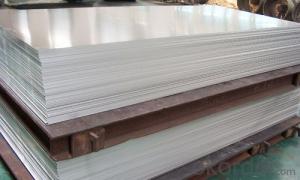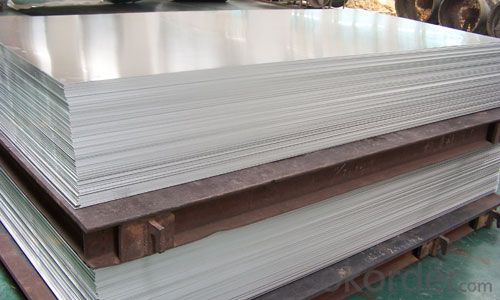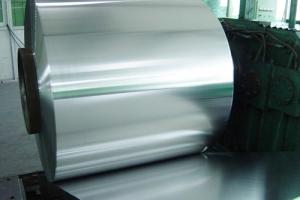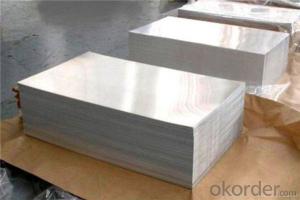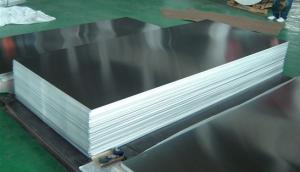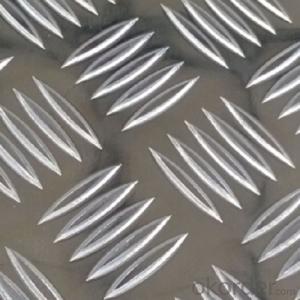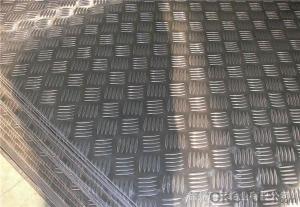Aluminum Siding Sheets (0.3mm Aluminum Plate)
- Loading Port:
- China Main Port
- Payment Terms:
- TT OR LC
- Min Order Qty:
- -
- Supply Capability:
- -
OKorder Service Pledge
OKorder Financial Service
You Might Also Like
quenching production line, tension straightening machine of pure Italian SELEMA, Germany HEGELISI CNC grinding machine, 1850m / m (1 +3) hot-rolling production line, led by the joint development of domestic and foreign, with the world’s most advanced secondary system, six roller cold rolling mill 1850 elevated four, three 2000mm aluminum foil rolling mill equipped with most advanced international level of the Swedish ABB AFC / AGC automatic flatness control system, as well as the column coating machine, packing machine out . Advanced and reliable technology solutions to achieve the project high-tech and high product quality goals
Width:80-1650mm,Lemper:500-6000mm,Thickness:0.3-15mm.
Alloy:1050、1060、1100、1200、1235、3003、3004、3A21、3102、3105、5052、8011.
Temper:H26、H28、O、F、H12、H14、H16、H18、H19、H22、H24、
The application field of aluminum is very widely, now our company involves and formed using scale main areas for signs of dial, antiseptic building engineering, vehicle manufacturing, refrigeration, electrical appliance manufacturing and pharmaceutical advertising decoration curtain wall industry
- Q: Can aluminum sheets be custom cut to specific dimensions?
- Yes, aluminum sheets can be custom cut to specific dimensions.
- Q: write a balanced equation for the reaction between aluminium metal and potassium hydroxide in water
- Hi there! So you're given Aluminum metal, which has the oxidation state (almost always) of 3+. In play are: Al 3+ K+ OH- You have KOH(aq) + Al 3+ and they react to form a precipitate, creating Al(OH)3 and the potassium cation disperses into solution. In traditional symbols: 3 KOH (aq) + Al 3+(s) ----- Al(OH)3(s) + 3K+ (aq) That's 3 K+, 3 OH-, and 1 Al 3+. That carries for both sides! NIE would look like: 3 OH- + Al 3+ ----- Al(OH)3 (s) Most instructors don't mind if you leave off (aq) but pretty much all of them care about (s), so make sure you add those phase states! I hope I helped :)
- Q: Can the aluminum sheets be used for manufacturing medical equipment?
- Yes, aluminum sheets can be used for manufacturing medical equipment. Aluminum is a versatile and widely used material in various industries, including healthcare. It has several properties that make it suitable for medical equipment manufacturing. Firstly, aluminum is lightweight yet durable, which is beneficial for portable medical devices. It allows for easier handling and transportation of equipment, especially for healthcare professionals who may need to move them frequently. Secondly, aluminum has excellent corrosion resistance, making it suitable for medical applications where cleanliness and hygiene are crucial. It can withstand disinfection processes without deteriorating, ensuring the longevity of the equipment. Additionally, aluminum can be easily sterilized, which is essential for medical equipment. It can withstand high-temperature sterilization methods, such as autoclaving, without any adverse effects on its structural integrity. Moreover, aluminum is an excellent conductor of heat and electricity. This property is advantageous for medical equipment that requires efficient heat dissipation or electrical conductivity, such as surgical instruments or diagnostic tools. Furthermore, aluminum is a non-toxic material, making it safe for medical use. It does not leach harmful substances, ensuring that it does not pose any health risks to patients or healthcare professionals. In conclusion, aluminum sheets can indeed be used for manufacturing medical equipment due to their lightweight, durability, corrosion resistance, sterilization capabilities, thermal and electrical conductivity, and non-toxic nature. These properties make aluminum a suitable choice for various medical applications, contributing to the advancement of healthcare technology.
- Q: How do you prevent scratches during transportation of aluminum sheets?
- To minimize the occurrence of scratches when transporting aluminum sheets, there are several steps that can be taken: 1. Adequate packaging: It is important to securely package the aluminum sheets using suitable materials like bubble wrap, foam, or cardboard. This will offer cushioning and protection against external impacts. 2. Application of protective layers: Inserting paper or plastic film between individual sheets will prevent direct contact and minimize the risk of scratching. 3. Secure stacking: When loading the aluminum sheets onto transportation vehicles, ensure they are stacked securely to prevent any movement or shifting during transit. This can be achieved by using appropriate strapping or palletizing techniques. 4. Gentle handling: Properly train personnel involved in the transportation process to handle the aluminum sheets with care. They should avoid dragging or sliding them against rough surfaces that could cause scratches. 5. Avoid contact with sharp objects: Take measures to ensure that the aluminum sheets do not come into contact with sharp objects or edges. This can be accomplished by keeping them separate from other materials or using protective covers. 6. Regular inspections: Regularly inspect the aluminum sheets during transportation to identify any potential scratches or damages. If any are discovered, immediate action should be taken to prevent further harm. By implementing these preventive measures, the likelihood of scratches occurring during the transportation of aluminum sheets can be significantly reduced. This will ensure that the sheets are delivered in optimal condition to their destination.
- Q: Can aluminum sheets be textured or patterned?
- Indeed, it is possible to texture or pattern aluminum sheets. Numerous techniques exist for achieving desired textures or patterns on aluminum sheets, including embossing, engraving, or etching. These methods entail modifying the surface of the aluminum sheet to achieve the desired texture or pattern. Furthermore, aluminum sheets can also be coated or painted with various finishes or colors to attain a specific textured or patterned appearance. In summary, by employing appropriate techniques and processes, aluminum sheets can be extensively transformed and personalized to possess a diverse array of textures and patterns.
- Q: Are aluminum sheets suitable for decorative purposes?
- Yes, aluminum sheets are suitable for decorative purposes. Aluminum is a versatile material that can be easily manipulated into various shapes and designs, making it ideal for decorative applications. It can be cut, bent, and formed into different patterns, allowing for endless possibilities in creating decorative elements. Additionally, aluminum sheets can be coated or painted in different colors and finishes to further enhance their aesthetic appeal. Furthermore, aluminum is a lightweight and durable material, which makes it suitable for both indoor and outdoor decorative use. It is resistant to corrosion, ensuring that the decorative elements made from aluminum will retain their appearance and last for a long time. Overall, aluminum sheets offer a wide range of design possibilities and practical benefits, making them an excellent choice for decorative purposes.
- Q: what will happen when aluminum sheet is put into copper chloride solution?
- the chemical equation of the reaction, 2Al+3CuCl2=2AlCl3+3Cu, the phenomena when aluminum sheet is put into copper chloride solution: there is red solid generating on the surface of aluminum sheet.
- Q: This question asks if aluminum sheets can be utilized for both exterior and interior purposes.
- <p>Yes, aluminum sheets can be used for both exterior and interior applications. They are popular for exterior use due to their durability, resistance to weather, and low maintenance requirements. For interior applications, aluminum sheets are valued for their lightweight, easy installation, and aesthetic appeal. They are commonly used in construction, automotive, and aerospace industries, among others. However, it's important to note that specific treatments or coatings may be necessary to enhance their performance in different environments.</p>
- Q: Can aluminum sheets be used for bus shelters?
- Indeed, bus shelters can utilize aluminum sheets. Aluminum, a lightweight and enduring substance, finds extensive use in construction ventures, encompassing bus shelters. Its exceptional resistance to corrosion renders it apt for outdoor scenarios, where it confronts inclement weather. Moreover, aluminum sheets are conveniently malleable and can be fashioned into manifold forms and dimensions, permitting tailor-made designs and effortless installation. Employing aluminum sheets for bus shelters also entails a cost-efficient resolution as it demands scant upkeep and boasts a prolonged existence.
- Q: Can aluminum sheets be used for air ducts?
- Indeed, air ducts can utilize aluminum sheets. Aluminum, known for its lightweight and durable characteristics, is frequently employed in air ducts. Its resistance to corrosion renders it a suitable option for HVAC systems. Air ducts are often constructed using aluminum sheets due to their malleability, enabling easy bending and shaping to meet specific dimensions. Moreover, aluminum boasts commendable thermal conductivity, ensuring efficient heat transfer within the ducts. Ultimately, opting for aluminum sheets in air ducts proves to be a pragmatic and efficient decision.
Send your message to us
Aluminum Siding Sheets (0.3mm Aluminum Plate)
- Loading Port:
- China Main Port
- Payment Terms:
- TT OR LC
- Min Order Qty:
- -
- Supply Capability:
- -
OKorder Service Pledge
OKorder Financial Service
Similar products
Hot products
Hot Searches
Related keywords

